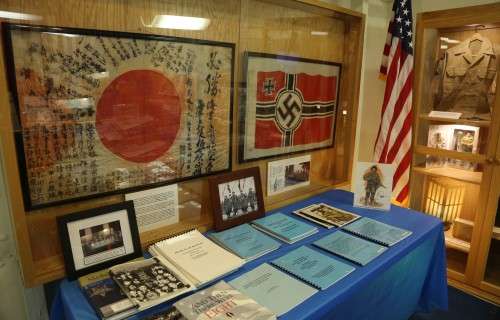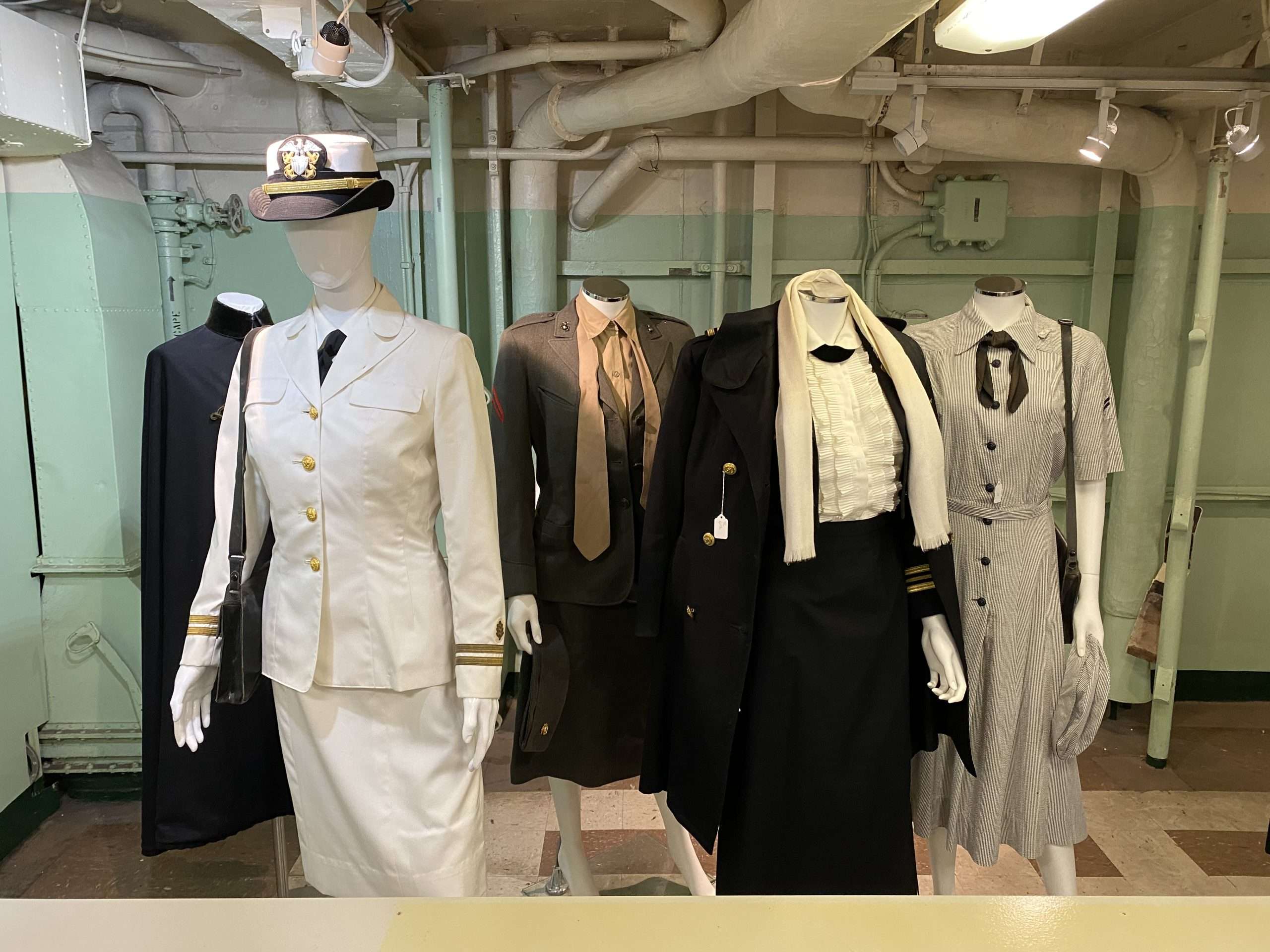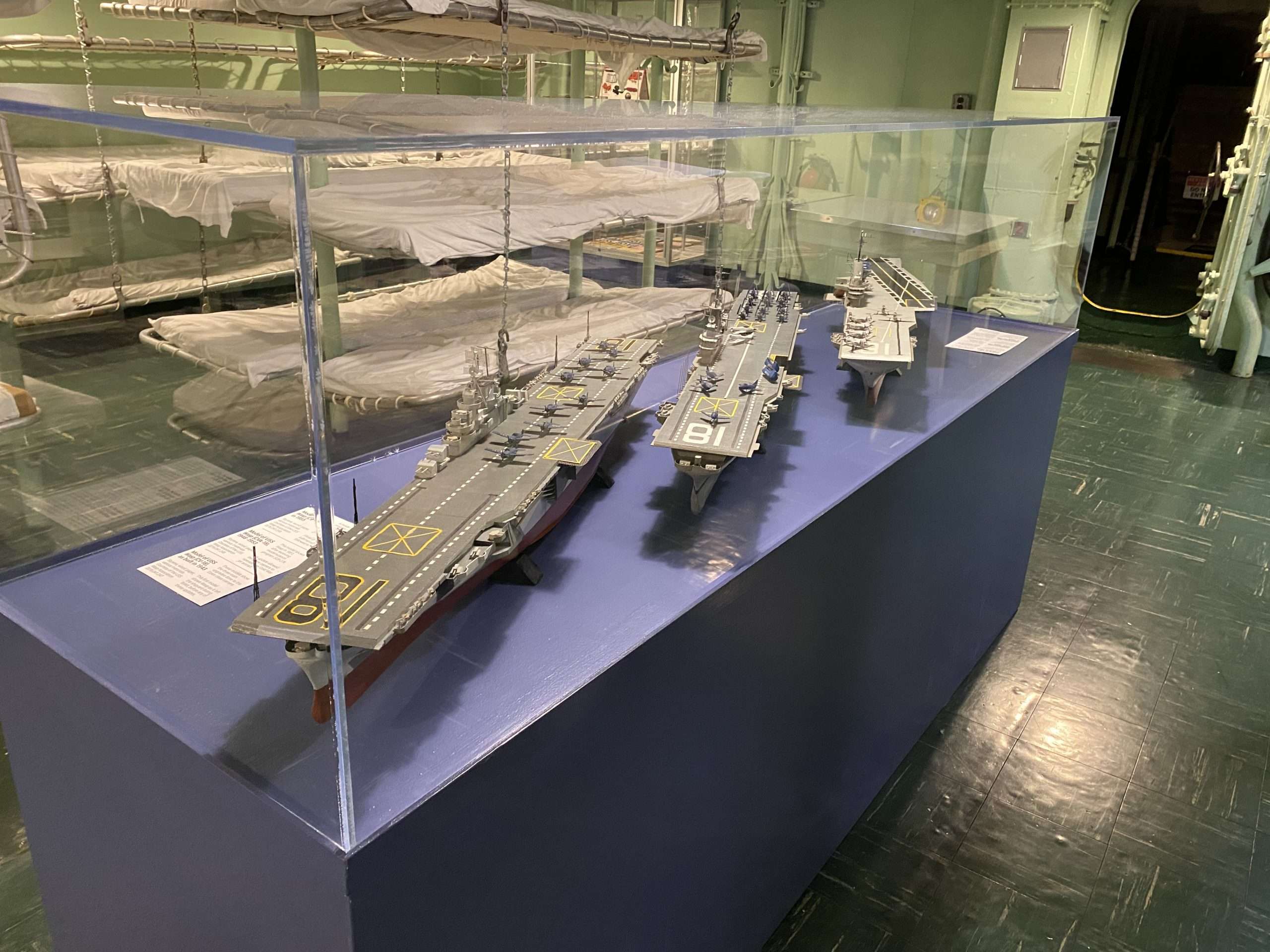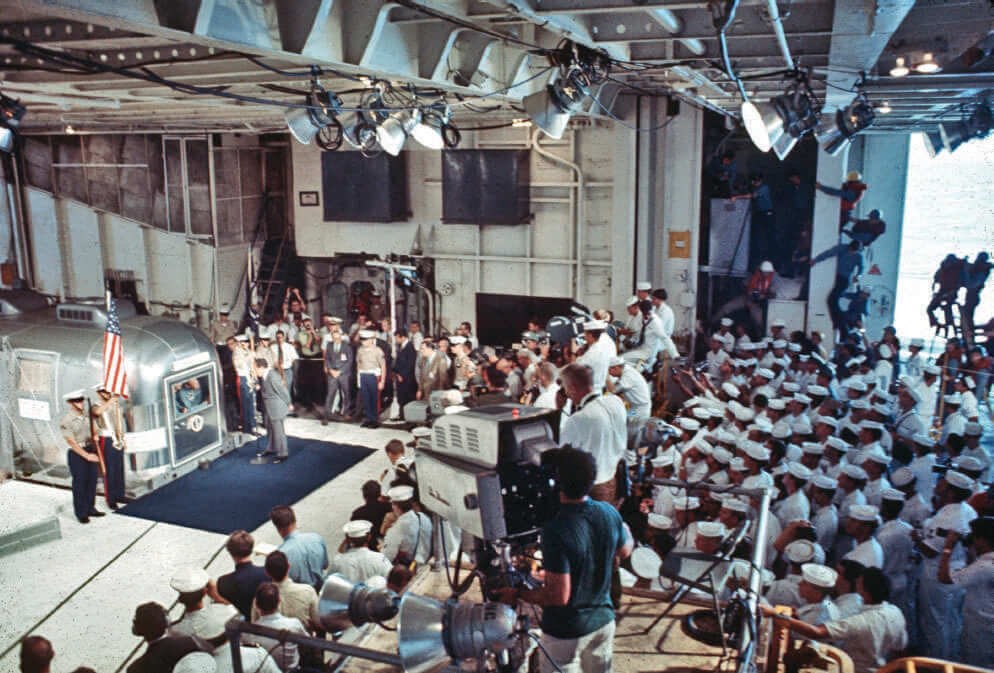The Space Race / Apollo Splashdown
In Hornet’s hangar bay, see larger artifacts from the Space Race between the USA and the USSR. This display includes Gemini Boilerplate MSC-307, Apollo test capsule CM-011, the Mobile Quarantine Facility from Apollo 14, and authentic military helicopters like those used during the Mercury, Gemini, and Apollo recoveries.
The Apollo Splashdown Exhibition starts in a living room, modeled after a typical 1960s American home. Visitors share the experience of millions of Americans in 1969, watching people walk on the moon for the first time.
In the main gallery space, the exhibit focuses on the Apollo 11 and 12 moon landings, which USS Hornet recovered from the Pacific Ocean. Artifacts include an early Grumman Corp. model for the Lunar Landing Module (the LEM), artifacts made and distributed to the Hornet crew during the missions, and popular memorabilia from the time.
NASA’s Apollo Mission Splashdown!
Compiled and Written by Museum Historian Bob Fish
USS Hornet (CVS-12) was selected by the Navy as the Prime Recovery Ship (PRS) for Apollo 11, America’s first lunar landing mission. On July 24, 1969, President Richard Nixon, ADM John S. McCain (CINCPAC) and several other dignitaries were present while Hornet recovered astronauts Neil Armstrong, Buzz Aldrin, and Michael Collins and their spacecraft Columbia. Armstrong and Aldrin were the first two humans to walk on the Moon.
The Navy units embarked on USS Hornet that participated in the Apollo 11 recovery were: Helicopter Anti-submarine Warfare Squadron Four (HS-4) flying the Sikorsky SeaKing SH-3D helicopter; Underwater Demolition Teams Eleven and Twelve (UDT-11 and UDT-12); Airborne Early Warning Squadron VAW-111 flying the Grumman E-1B Tracer, and Fleet Logistics Support Squadron VR-30 flying the Grumman C-1A Trader.
The eight-day Apollo 11 mission marks the first time in mankind’s history that humans walked on the surface of another planetary body. On July 20, 1969, two astronauts, Mission Commander Neil Armstrong and LM pilot Edwin “Buzz” Aldrin Jr, landed on the Moon in the Lunar Module (LM) Eagle. During a historic 2 ½ hour lunar surface excursion, the astronauts set up scientific experiments, took photographs, and collected rock and soil samples. After the Eagle rendezvoused with the Command Service Module (CSM) Columbia, the astronauts returned to Earth, landing in the Pacific Ocean on July 24. Apollo 11 fulfilled President John F. Kennedy’s challenge for America to land a man on the Moon and return him safely to Earth before the 1960’s decade had ended.
Apollo 11 was launched on a Saturn V on July 16, 1969 from Kennedy Space Center in Florida. After 1 ½ Earth orbits, the S-IVB stage was re-ignited, putting the spacecraft on course for the Moon. The S-IVB was fired again once the CSM reached the Moon to insert the spacecraft into orbit around it. On July 20, Neil Armstrong and Buzz Aldrin entered the Lunar Module (LM) Eagle and descended to the lunar surface. The LM landed in the Sea of Tranquility with Armstrong reporting, “Houston, Tranquility Base here – the Eagle has landed.” Armstrong stepped onto the lunar surface several hours later stating, “That’s one small step for a man, one giant leap for mankind.”
Aldrin descended the ladder several minutes later. Both astronauts unveiled a plaque on the LM descent stage with the inscription: “Here Men From Planet Earth First Set Foot Upon the Moon, July 1969 A.D, We Came In Peace For All Mankind.” The astronauts deployed the scientific instruments, took photographs, and collected 22 kilograms of lunar rock and soil samples. The astronauts traversed a total distance of about 250 meters. The EVA ended after 2 hours, 31 minutes when the astronauts returned to the LM and closed the hatch.
After spending over 21 hours on the lunar surface, the Eagle blasted off. Once the LM had docked with Columbia, the two astronauts transferred to the CM, and the LM was jettisoned into lunar orbit (the crash site of the Eagle on the Moon is still unknown).
Three days later, just before Columbia was positioned for reentry into Earth’s atmosphere, it was separated from the Service Module. Apollo 11 splashed down in the Pacific Ocean on July 24 at 5:50 AM local time, after traveling over 950,000 miles in a little more than 8 days. The splashdown point was 920 miles southwest of Honolulu and 13 miles from USS Hornet.
Four months later, USS Hornet (CVS-12) repeated this flawless performance as PRS for the recovery of Apollo 12, America’s second lunar landing mission. On November 24, 1969, the spacecraft Yankee Clipper, with its all-Navy astronaut crew of Pete Conrad, Alan Bean and Dick Gordon, splashed down just a little over 2 miles from the aircraft carrier.
Artifacts at the Museum
Apollo Test Capsule CM-011
on loan from the Smithsonian’s National Air and Space Museum
NASA’s Command Modules (CM) were built by Rockwell of North
American, based in Downey, California. This module, CM-011, was built in the Bock I design and was a testing capsule. The Command Module design was under construction before the plan to orbit the Moon was chosen so the first CMs were only designed for Earth orbit and lacked docking capability and a pressurized crew-transfer tunnel. These features were added to the next Command Module design, Block II, which connected to the Lunar Excursion Module (LEM) to allow two astronauts to travel to the lunar surface and return to the Command Module which would remain in lunar orbit.
USS Hornet served as the recovery ship for CM-011 for its AS-202 mission. The Command Module was recovered off of Wake Island on August 25, 1966, 1 hour and 33 minutes after liftoff. Following the mission, engineers from NASA Rockwell/North American conducted a land impact test, dropping the capsule from a platform. This tested the structural integrity of the spacecraft and heat shield after it had gone through the cold vacuum of space and the heat of reentry. On this test, the capsule was dropped at a 23-degree angle, resulting in a crack at its base that can still be seen today.
Gemini Boilerplate
Gemini Boilerplate MSC-307 on loan from the W Foundation
This boilerplate, Capsule MSC-307, was most likely built to test and evaluate the size and shape of the Gemini capsule design. There is no indication that it was ever outfitted for actual astronauts, but it would have been used for splashdown recovery training in preparation for the manned Gemini missions.
In spacecraft design, a boilerplate is a non-functional item that meets spacecraft “form and fit” requirements only and tests the developing design against a small number of specific design requirements. Boilerplate models are an economic way to test spacecraft designs as they evolve into their final, fully functional shapes. Boilerplate tests are used to validate flight loads, aerodynamic performance, and interfaces with other parts of the launch system, as well as to develop procedures for emergency entry and exit, maintenance support, ground handling, and transportation. The boilerplates were used during the development of the Mercury, Gemini, and Apollo manned space vehicles.
Mobile Quarantine Facility
A Mobile Quarantine Facility from Apollo 14
This Airstream trailer is called a Mobile Quarantine Facility (MQF). MQF trailers were built by NASA to be used for Apollo missions 11, 12, 13, and 14. The astronauts of Apollo 11 were the first people to set foot on the Moon and scientists worried they might return with an infection that could harm Earth’s inhabitants or ecosystem. NASA decided to quarantine the astronauts, equipment, and lunar samples returning from the Moon’s surface for a period of 21 days. NASA planned to quarantine the first four lunar missions–Apollo 11, 12,13, and 14–to determine if Moon germs existed. The astronauts had to leave the recovery helicopter after splashdown and immediately enter the MQF. They were then closed in the MQF along with a flight surgeon.
This MQF is serial number 004. It was the prototype model and eventually used to house the crew of Apollo 14. Astronauts Alan Shepard, Edgar Mitchell, and Stuart Roosa, along with a flight surgeon and a vehicle technician, lived inside this MQF from February 9-12, 1971. Apollo 14 was the last flight to be subjected to quarantine procedures.
SeaKing Helicopter
Sikorsky SH-3H SeaKing Helicopter on loan from the National Museum of Naval Aviation
On June 7, 1965, this helicopter recovered the crew of Gemini 4 in the Atlantic Ocean while serving aboard USS Wasp. Gemini 4 was the mission where Ed White became the first American astronaut to walk in space. Sikorsky SeaKings have played a vital role in the American space program in recovering Mercury, Gemini, Apollo, and Skylab mission crews. SeaKing helicopters of Helicopter Squadron 2 served aboard USS Hornet from 1962 to 1970, and Helicopter Squadron 4 during the Apollo 11 and 12 recoveries in 1969.




